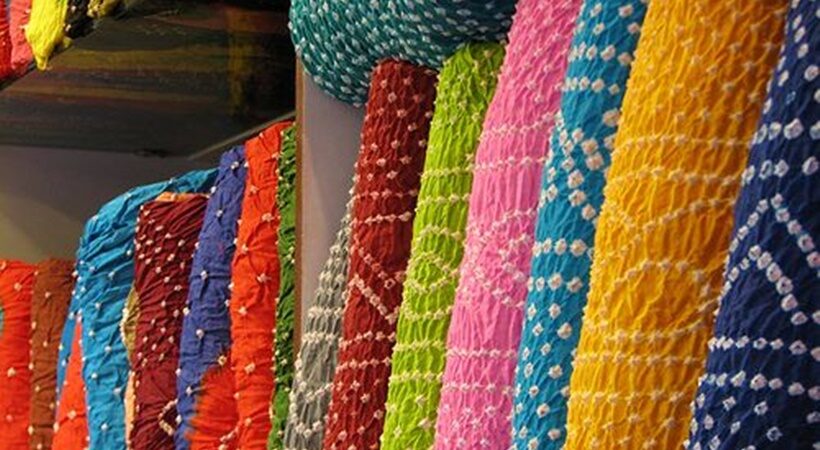Bandhani is a resist-dyeing technique, also referred to as Bandhej, of colouring cloth—traditionally silk, cotton and wool in patterns by blocking colour on predetermined areas on the fabric and tying them tightly with a thread followed by dyeing. Bandhani is derived from the *Sanskrit word ‘bandhana’, which means binding, tying or fastening and is the oldest tie and dye tradition still in practice. It is believed to have originated in the Kutch region in Gujarat some 5,000 years ago and artisans producing Bandhani textiles are clustered in the western Indian states of Rajasthan and Gujarat.
The first step in producing Bandhani textile involves soaking, washing and bleaching the fabric to remove starch in order to improve its capacity to retain the dye. After the design is traced on the cloth, it is folded and parts of the fabric are raised with a pointed metal nail worn over the finger. The raised portions are tied with a cotton thread coated with wax to create a dot, which is the basic motif of the Bandhani design.

The tied fabric is dyed in colours, from lightest to darkest shades and is tied and re-tied multiple times after which it is rinsed and dried. Based on the patterns commonly used resist materials include thread, wax, rice or mud-paste. Traditionally, Bandhani was the preserve of the Khatri communities of Kutch and Saurashtra, who are believed to have imported it from Sindh. Gharcholu, chandrokhani, aba, khombu and shikari are the different patterns in which Bandhani is made.
The earliest known reference to Bandhani can be traced back to the sixth century at the Ajanta cave paintings, which portray women in fabrics produced by resist dyeing. Literary references can also be found in the seventh-century biography of King Harsha by Banabhatta, which discusses the tie-dyed technique used in the bride’s wedding attire. Exquisite Indian textiles were also produced for elite consumption and the Mughal emperors. Akbar and Jahangir are known to have prominently displayed Bandhani textiles in their royal portraits.
Bandhani designs are also clearly depicted in early 17th century Mughal paintings such as “The Elderly Akbar Receives Murtaza Khan” by Manohar and Balchand’s portrait of Jahangir. In “Akbar Receives News of the Victory of Gogunda”, the emperor can be seen wearing a cotton black and red coloured Bandhani waist-tie.
In the A’in-i Akbari, Abu’l Fazl dedicates a section to the emperor’s wardrobe and mentions the bandhnun cloth as a specialty of the Rajput domain in western India. According to the author of Mirat-ul-Istilah, an eighteenth-century lexicon of courtly idioms, the craft of Bandhani is analogous to the growth of a garden which is a reference to the diversity of colours and dot motifs used in Bandhani resembling a flower bed.
Bandhani textiles are also frequently used for weddings and religious rituals among Hindus and some Muslim communities of western India. Odhanis or head clothes are worn by women, featuring patterns created by fine tie-dyed dots and during weddings, the bride’s sari and the groom’s turban are made of Bandhani textiles.



















